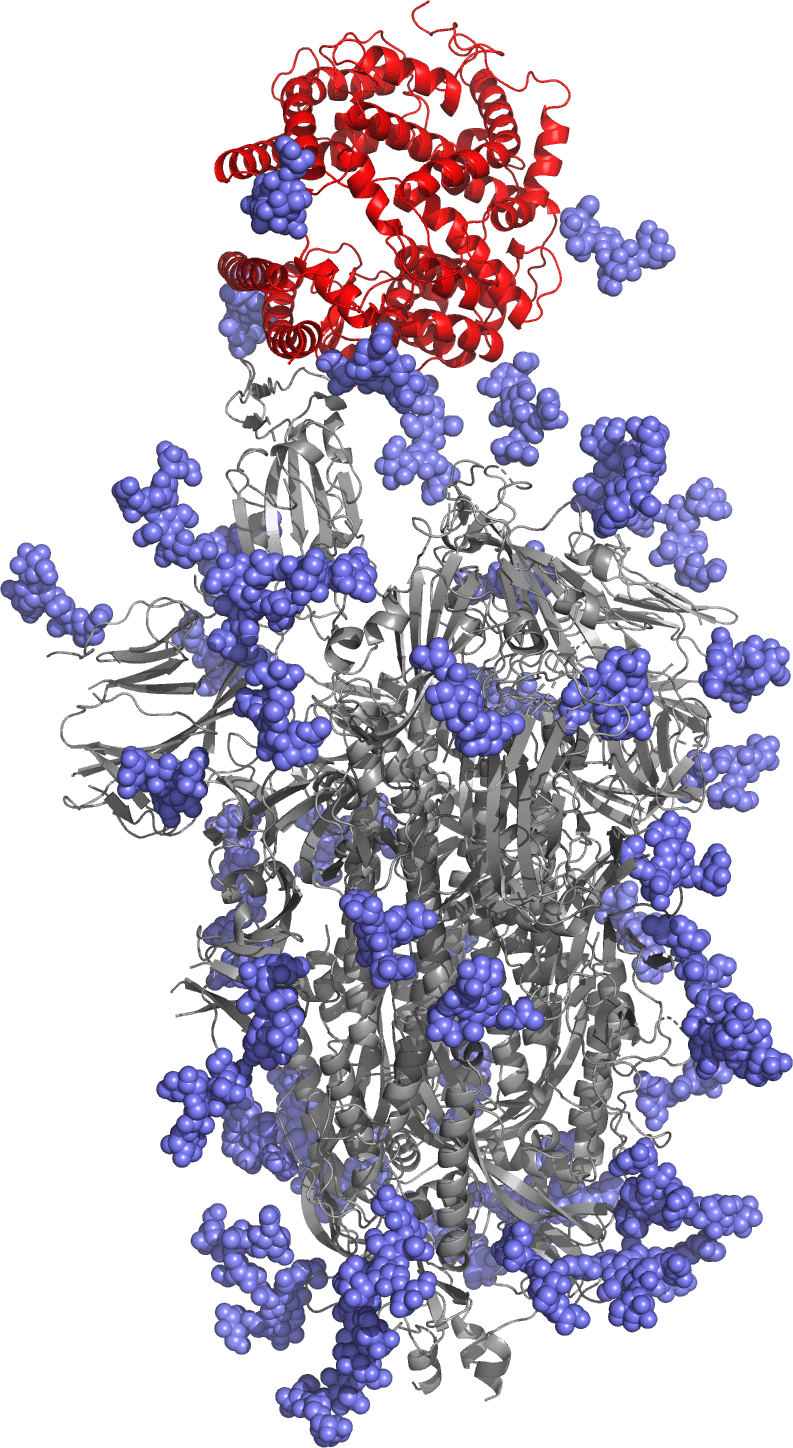
The SARS-CoV-2 spike protein in grey with the host receptor in red. The Phylex antigen is made of regions of the spike protein close to the receptor. Natural sugars carried by the protein are in blue.
AI DESIGN OF ANTIGENS
Recent progress in computational analysis and artificial intelligence deep learning allows us to design antigens that elicit specific classes of neutralizing antibodies, the primary defense against viral infection. These neutralizing antibodies prevent virus entry into the host cell.
For our SARS-CoV-2 vaccine, the Phylex antigen is based on regions of the viral spike protein close to the host receptor. The vaccine is designed to protect against the current variants of concern of the SARS-CoV-2 coronavirus, including the KP.3 variant now prevalent worldwide, all with increased transmissibility and resistance to current vaccines. It is a complement vaccine, designed to elicit neutralizing antibodies differing from the antibodies elicited by previous and current vaccines and breakthrough infections, and to address the major issue of immune imprinting.
For our Nipah vaccine the antigen is based upon the head domain of the G attachment protein of the Nipah virus, and displays most epitopes of neutralizing antibodies.
All our vaccines are nanoparticles that enhance protection against viral dissemination and neuropathology associated with viral infection, such as long COVID syndrome and Nipah encephalitis.
Recent progress in computational analysis and artificial intelligence deep learning allows us to design antigens that elicit specific classes of neutralizing antibodies, the primary defense against viral infection. These neutralizing antibodies prevent virus entry into the host cell.
For our SARS-CoV-2 vaccine, the Phylex antigen is based on regions of the viral spike protein close to the host receptor. The vaccine is designed to protect against the current variants of concern of the SARS-CoV-2 coronavirus, including the KP.3 variant now prevalent worldwide, all with increased transmissibility and resistance to current vaccines. It is a complement vaccine, designed to elicit neutralizing antibodies differing from the antibodies elicited by previous and current vaccines and breakthrough infections, and to address the major issue of immune imprinting.
For our Nipah vaccine the antigen is based upon the head domain of the G attachment protein of the Nipah virus, and displays most epitopes of neutralizing antibodies.
All our vaccines are nanoparticles that enhance protection against viral dissemination and neuropathology associated with viral infection, such as long COVID syndrome and Nipah encephalitis.
mRNA NANOPARTICLE
We have also developed a flexible mRNA nanoparticle platform for the rapid development of our vaccine candidates. A messenger RNA directly encodes for the self-assembling nanoparticle. This highly immunogenic nanoparticle displays 60 copies of the antigen and has a size, geometry and symmetry mimicking the virus. Recent results* show that our mRNA nanoparticle-based vaccine elicits a robust immune response with neutralizing antibodies and protective immunity against the delta variant of the SARS-CoV-2 coronavirus.
*A mRNA vaccine encoding for a RBD 60-mer nanoparticle elicits neutralizing antibodies and protective immunity against the SARS-CoV-2 delta variant in transgenic K18-hACE2 mice
Frontiers in Immunology original research article published on July 6, 2022
We have also developed a flexible mRNA nanoparticle platform for the rapid development of our vaccine candidates. A messenger RNA directly encodes for the self-assembling nanoparticle. This highly immunogenic nanoparticle displays 60 copies of the antigen and has a size, geometry and symmetry mimicking the virus. Recent results* show that our mRNA nanoparticle-based vaccine elicits a robust immune response with neutralizing antibodies and protective immunity against the delta variant of the SARS-CoV-2 coronavirus.
*A mRNA vaccine encoding for a RBD 60-mer nanoparticle elicits neutralizing antibodies and protective immunity against the SARS-CoV-2 delta variant in transgenic K18-hACE2 mice
Frontiers in Immunology original research article published on July 6, 2022
COUNTERING IMMUNE IMPRINTING
A major issue with all current COVID-19 vaccines is immune imprinting. Immune imprinting describes a narrow immune memory, limited to the wild type SARS-CoV-2 virus. Immune imprinting is caused by initial infection, as well as first and second generation vaccines and breakthrough infections. All vaccines to date contain epitopes in the spike protein common to the wild type SARS-CoV-2 virus that are preferentially recognized by the limited immune memory and elicit a narrow immune response. Our vaccine elicits different neutralizing antibodies that complement and broaden the immune response.
A major issue with all current COVID-19 vaccines is immune imprinting. Immune imprinting describes a narrow immune memory, limited to the wild type SARS-CoV-2 virus. Immune imprinting is caused by initial infection, as well as first and second generation vaccines and breakthrough infections. All vaccines to date contain epitopes in the spike protein common to the wild type SARS-CoV-2 virus that are preferentially recognized by the limited immune memory and elicit a narrow immune response. Our vaccine elicits different neutralizing antibodies that complement and broaden the immune response.
